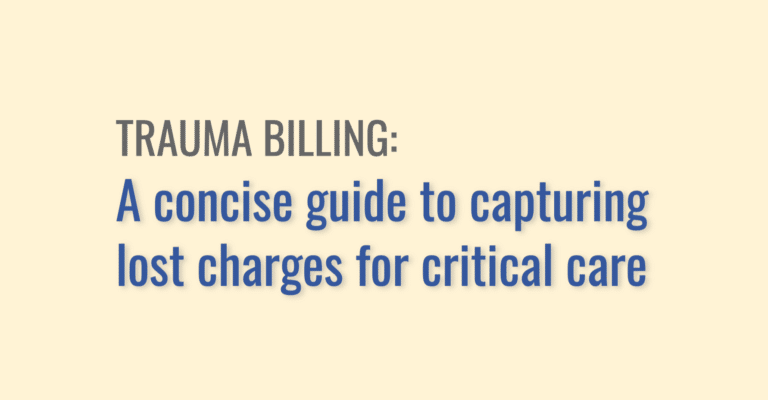A trauma team must provide at least 30 minutes of critical care before the hospital can bill for a trauma activation, so failure to capture critical care charges will reduce trauma program revenue dramatically.
Unfortunately, critical care billing is widely misunderstood by both trauma program leaders and hospital finance departments. As a result, many trauma programs fail to capture a significant percentage of critical care charges. That leads to lost trauma response fees.
These losses are unnecessary. In this article, I identify common misunderstandings about critical care billing, explain why they are wrong, and show how to ensure full capture of critical care charges and optimal trauma center revenue.
Two reasons trauma centers lose critical care charges
Based on my experience in trauma centers nationwide, there are two common misunderstandings about critical care billing.
Misunderstanding #1: Only physician time counts as critical care time. According to the Centers for Medicare & Medicaid Services (CMS), a trauma team must provide at least 30 minutes of critical care in order to bill for a trauma team activation. Many billers think this means 30 minutes of physician time. In fact, CMS regulations state that critical care time can include care delivered by either physicians or hospital staff.
(For more information on this point, read my recent article on trauma charge capture: 5 coding and billing mistakes that reduce trauma center revenue.)
Remember, the critical care charge discussed here is the facility fee, not the physician’s professional fee. This is where the misunderstanding often comes into play. If a trauma surgeon spends only 20 minutes with a patient during an activation but the trauma team as a whole spends 45 minutes providing care:
- The surgeon cannot submit a professional charge for critical care.
- However, the hospital can submit a facility charge for critical care.
Misunderstanding #2: Only “critically ill” patients can receive critical care. Clinicians think of critical care as activities like intubation, massive transfusion, central line placement and other invasive procedures. In other words, many believe the patient must present in a “critical state” for there to be a critical care charge. This is not true. From a billing standpoint, critical care does not refer to the patient’s condition but to the level of care necessary to identify potentially life-threatening injuries.

Think about what happens during a trauma team activation. The patient arrives with a high index of suspicion for critical injury. The trauma team provides continuous, face-to-face care to determine whether the patient has any hidden injuries or needs immediate intervention. Ultimately, the patient may prove not to have a critical need, but from a billing perspective that is beside the point. The time spent evaluating the patient is considered critical care.
Here’s another way to look at it. As everyone knows, the full title of the Orange Book is Resources for Optimal Care of the Injured Patient. Note that the focus is the injured patient, not the critically injured patient.
For critical care, the key issue is time
Critical care codes are time-based. So when does critical care time start and stop? In the context of a trauma activation:
- Critical care time starts when the patient arrives
- Critical care time ends when the patient has been cleared of any life-threatening injuries or moves to the next phase of care
Say a patient involved in a motor vehicle crash arrives at the trauma center with a trauma team activation. The patient receives critical care before being stabilized.
- If the patient is then waiting for admission to a non-ICU setting, critical care time will have ended at the point when one-on-one care was no longer necessary.
- However, if the patient is being admitted to the ICU — and presumably still requires one-on-one care — the trauma team’s critical care time will continue until ICU disposition.
What happens when the trauma team activates but the patient is rapidly cleared? Again, the key issue is time. The thing to remember is that critical care time ends when it is determined the patient is no longer in jeopardy.

The same principles apply to patients who are DOA or who die in the ED soon after arrival. If a team response does not include at least 30 minutes of critical care, it does not meet the critical care requirement for billing a trauma team activation.
How to ensure full capture of critical care charges
1. Clarify your ED critical care policy. A trauma center can avoid a lot of problems if its critical care policy aligns with trauma billing requirements. The policy should specify that trauma team activation includes critical care. In addition, make sure the policy spells out the components of critical care — typically, one-on-one care, vital sign frequency and documentation standards. If the ED critical care policy does require updating, go through your hospital’s normal policy approval process.
2. Ensure proper documentation of critical care. I recommend structuring the trauma flow sheet to capture all data required by your center’s critical care policy. Capturing stop times is the biggest challenge, so assign a scribe nurse during the evaluation and resuscitation period and make sure he or she understands the nuances of critical care timing. Documentation should include:
-
- Time of pre-hospital notification (if applicable)
- Notification and arrival time of each trauma team member
- Patient arrival time (which must be documented to start the critical care time clock)
- Vital signs, as specified in your hospital’s trauma activation policy (for example, q5 mins x 15 mins, q15 mins x 4, then as patient condition dictates)
- Trauma team activation stop time (essentially, the end of critical care time)
3. Meet with the compliance department. Even before you talk to coders, meet with representatives of the hospital compliance department to gain agreement on critical care regulations. Explain what you are trying to do with trauma billing and go over critical care rules. Gaining buy-in from compliance is key to making headway with the central business office.
4. Educate billers on critical care requirements. CMS requirements for billing critical care as part of a trauma response are:
- Pre-notification by healthcare providers
- Registration of the patient as Field Locator (FL) 14 patient type 5
- Organized trauma team response
- 30 minutes of one-on-one care (critical care)
If the team fulfills the requirements listed above, the hospital can submit a charge for the trauma response fee. When submitting this charge under revenue code 68x, the bill must also report:
- HCPCS code G0390 for “trauma response team associated with hospital critical care service”
- CPT 99291 for the first 30 to 74 minutes of critical care (and CPT 99292 for each additional 30 minutes)
If the patient has not received 30 minutes of critical care, there will be no CPT 99291 and therefore the hospital will not report G0390. However, the hospital can still report a 68x revenue code without G0390. There will be no trauma response fee reimbursement, but the cost of the activation will be included in the facility’s Hospital Cost Report, which will ultimately benefit the hospital.
One final reminder: The requirements described above are Medicare’s rules. However, other payers account for up to 70% of reimbursement for most U.S. hospitals, and these commercial payers may have different parameters for trauma billing. For example, not all payers require pre-notification or 30 minutes of critical care in order to submit the trauma response fee. Work with the finance department to understand any specific requirements or opportunities in your hospital’s commercial payer contracts. The ideal forum for this discussion is a dedicated Trauma Finance Committee.


11 Comments
Good morning,
In light of the current OIG audits occurring across the nation with critical care billing and activation billing at Trauma Centers has any of this information changed? My coders will not bill on the premise that critical injury means treating suspected injuries. They will only bill if the patient has a documented critical injury (which I disagree with but I have no say in the matter as our compliance team have also taken this stance.)
Any information would help me in my defense. Thanks
Thanks for the question, Lisa. We are broadcasting a webinar tomorrow (February 28, 2024) that will cover the OIG audit and related questions in trauma center payment. Here is the link to register: https://us02web.zoom.us/webinar/register/1517083763489/WN_zUVUWntTSemHUsYN0T3aZQ
Hi, I am wondering if you can clarify the regulations of trauma activation ? Does the patient has to arrive via ambulance, helicopter or medical professionals vehicle only to qualify for trauma activation? Can patients arrived via private vehicle or walk-in? Thank you,
Thanks for the question, Sophiayia. As it happens, Trauma System News is broadcasting a webinar tomorrow (February 28, 2024) that will address this question. Here is the link to register for the webinar: https://us02web.zoom.us/webinar/register/1517083763489/WN_zUVUWntTSemHUsYN0T3aZQ
Hi, I am wondering if the webinar mentioned in the above replies from February 28, 2024 is available to view. Thank you.
Hi, Lindsay: Yes, the webinar replay is still available. Here is the link: https://us02web.zoom.us/rec/share/T4OQI1ihr673M8btjoAodlT6hD7exYPfitKweNdU2TOGCbJzSt7Tg4SXJuVZYehm.sc2byD8Qr18dDQKJ?startTime=1709145932000
Thanks for your interest!
Is there an email address for Angie? I was not able to join the live webinar.
Kristie, you can access the webinar replay and the slides from this page: https://trauma-news.com/2024/09/webinar-beyond-the-measures-of-compliance-nuances-documentation-challenges-and-easily-missed-details-in-the-acs-trauma-standards/
Hi Kristie,
You can reach me at angie.chisolm@optimalhealthcareadvisors.com or by calling 727-236-1352.
Angie
Can medications be charged sole off of the trauma flow sheet
Charging for medications is based on the facility’s documentation requirements. For example, if you use OmniCell or Pyxis – charges can be generated when medication is dispensed, or charges can be applied based on nursing documentation of administration – as is the case with IV fluids. With Epic EHR and Epic billing, the trauma flowsheet can be the source of medication administration documentation and billing. You’ll need to check with your revenue cycle manager and pharmacy to determine the practice at your facility.